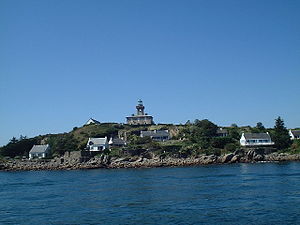Îles Chausey
| Îles Chausey | ||
|---|---|---|
| Grande-Île with the Phare de Chausey lighthouse | ||
| Waters | Gulf of Saint Malo | |
| Geographical location | 48 ° 52 ′ N , 1 ° 49 ′ W | |
|
|
||
| Number of islands | 22nd | |
| Main island | Grande-Île | |
| Total land area | 0.52 km² | |
The Îles Chausey (Eng. Chausey Islands ) are a small group of islands belonging to France in the English Channel 15 kilometers west of the Normandy coast at the Pointe du Roc headland in the city of Granville . It consists of more than 22 individual islands, the largest of which is called Grande-Île . Only the Grande Île is populated; In addition to a lighthouse, there are a few dozen houses that are mainly inhabited in summer.
In the main season there is a daily ferry connection to the mainland. There are no connections to other Channel Islands .
geography
The Chausey Islands consist of the main island Grande-Île and up to 365 other islands at low tide and around 52 islands at high tide. The archipelago has a very large tidal range of up to 14 meters. From the town of Granville , to which the archipelago belongs administratively, the islands can be seen well when the weather is nice. The islands consist mainly of deep rock (precambian granite). The erosion by sea and wind shaped the current surface of the archipelago. Sandbanks connect the islands with each other. The Cromlech de l'Oeillet is located in the tidal area northeast of the Grande-Île.
Grand-Île is the only inhabited island in the group with a population of around 30. In summer, tourism, which is a major source of income for the island, brings almost 200,000 visitors a year. There is a hotel, a restaurant and a grocery store on the island. Besides tourism, fishing is the most important economic activity. Mussels and oysters are raised on site. Until 1989 there was a cattle ranch on the island.
The typical boats from Chausey are the dories , flat bottom boats that are traditionally powered by oars, or nowadays powered by an engine. Every August the Chausey Regatta takes place on the first weekend of the Nipp tide .
prehistory
Next to the Cromlech de l'Oeillet , a stone circle in the tidal area north of the Grand Île, are the dolmen Maison des Morts and Pierre du Sacrifice (or Dolmen de la Chapelle ) on the Grand Île. On or in front of the side island of La Genetaie there are four stone boxes ( French: Coffre 1 - 4 ).
history
In 933 the Duchy of Normandy annexed the Channel Islands including Chausey, Minquiers and Ecrehous. Richard II , Duke of Normandy, gave Chausey and the barony of Saint-Pair-sur-Mer to the Benedictine monks of Mont Saint-Michel , who built a priory on the Grande île . The islands became subject to the Kingdom of England after the conquest of England by William, Duke of Normandy in 1066. Chausey has long been a target of rivalry between England and France. Although the British government has claimed that Chausey belonged to England until around 1764. Chausey, unlike its neighbors on the Channel Islands, has actually been French for centuries.
In contrast to the neighboring Channel Islands, the archipelago has only been properly inhabited since the 13th century. Originally the widely branched archipelago was used as a hideout for pirates and smugglers. The granite found here was later mined on a large scale and used in particular for the construction of the Mont-Saint-Michel . But rocks from Chausey can also be found in London , Paris and Dieppe . In the 19th century, up to 500 stonemasons lived on the islands at times .
The fortress of Matignon was built in 1559 as a square fortress with a round tower, cellar, bakery and cattle shed. The English destroyed the fortress in 1744. A new fortress was built at the other end of the island, which the English also destroyed in 1756. During the First World War , the fortress was used for around 300 German and Austrian prisoners of war. The automobile engineer Louis Renault bought the property and restored it between 1922 and 1924, so it became known as Château Renault. During the Second World War , German soldiers occupied the fortress. Today the fortress serves as accommodation for several fishermen.

